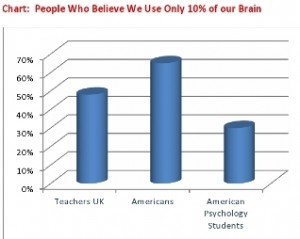
- Brain and 10 Percent Myth Image by new 1lluminati
What does a science fiction movie,the brain 10 percent myth and 1,135,000 have to do with each other?
The connection is through a much written about belief /myth that we only use 10 percent of our brain.
That we have untapped resources we can call upon. Another 90%!
This article looks further at the myth. Next week more about how it can impact on brain injury.
To begin. The science fiction movie is “Lucy” is a movie directed by Luc Besson, released in 2014. The plot created a flurry of articles and comments about the myth that we supposedly have 90% of our brain that we do not use.
‘Lucy’ is a woman who gains increased brain powers from the absorption of a certain drug. At one point gaining 100% of her brain function (very short version of a long story, and ” No” I haven’t seen the movie).
The 1,135,000 is the number of search results a Google search found for Lucy + 10 + Brain + Myth. That’s a lot of talk about a myth and a movie. This writer is about to make it 1,135,001!
The Brain 10 percent myth – here is a quick overview of the brain development and function that questions the brain 10 percent myth. “What percentage of your brain do you use?” is a short TED education talk by Richard E. Cytowic
Why Make it 1,135,001 ?
With so many people writing about Lucy and the 10% brain myth why add to it?
Despite the vast amounts of information the myth persists. This myth can impact people living with brain injury. More on these ideas below and in next week’s articles.
I was also curious to explore why I had so readily believed the myth to be fact in the past. I share my past flawed thinking here in the hope it will encourage anyone else who still believes the myth (or any other brain myth) to examine their own assumptions carefully and frequently.
I must have been a bit lazy in my research and smitten by the idea. As a result it linked together in my mind:
we don’t know all there is to know about the brain:
we all have untapped potential:
we only use 10% of our brain capacity:
therefore we could have a secret stash of unused brain somewhere.
It’s an exciting, hope-filled and compelling idea. Yet today in the examination room of my brain this does not stack up.
This is summarised well in a Smithsonian .com article “Myths about the Brain” in response to ‘We use only 10 percent of our brains’ Laura Helmuth explains:
…“Brains are expensive—it takes a lot of energy to build brains during fetal and childhood development and maintain them in adults. Evolutionarily, it would make no sense to carry around surplus brain tissue.” Experiments using PET or fMRI scans show that much of the brain is engaged even during simple tasks, and injury to even a small bit of brain can have profound consequences for language, sensory perception, movement or emotion.
True, we have some brain reserves. Autopsy studies show that many people have physical signs of Alzheimer’s disease (such as amyloid plaques among neurons) in their brains even though they were not impaired. Apparently we can lose some brain tissue and still function pretty well. And people score higher on IQ tests if they’re highly motivated, suggesting that we don’t always exercise our minds at 100 percent capacity.”
How prevalent is the brain 10 percent belief in ‘real’ life?
Yes there are many, many articles debunking the brain 10 percent myth. Yet there are those who continue to believe we only use 10% of our brain function.

Nathalia Gjersoe in an article in The Guardian “The Greatest Brain Myth There Ever Was”. describes the 10% myth as still being widely held. Quoting studies that found: “Of those asked, 48% of teachers in the UK, 65% of Americans and 30% of American Psychology students endorsed the myth.”
Ooops! That is still quite a lot of people who hold it to be true.
As I explained above I did once hold this myth to be true, I no longer do. How about you – a believer or a doubter?
As I reviewed a small sample of those 1,135,000 articles I mentioned above, most appeared to criticize and blame the movie. Which seems unfair given the belief has been around for much longer than the movie!
What you can see from this is that the myth has captured the imagination of writers, readers, movie-makers and many in the scientific community. Oh and me of course.
Where Did The Myth Begin?

The origin appears lost in time. Possibilities put forward include:
Christian Jarrett author of The 10 Percent Brain Myth, in an article “All You Need To Know About the 10 Percent Brain Myth, in 60 Seconds”explains:
“No-one knows for sure. A popular theory has it that the journalist Lowell Thomas helped spread the myth in his preface to Dale Carnegie’s block-buster self-help book How to Win Friends and Influence People. Thomas misquoted the brilliant American psychologist William James as saying that the average person specifically “develops only 10 percent of his latent mental ability.” In fact James had referred more vaguely to our “latent mental energy.” Others have claimed that Einstein attributed his intellectual giftedness to being able to use more than 10 percent of his brain, but this is itself a myth. Another possible source of the 10 percent myth is neurosurgeon Wilder Penfield’s discovery in the 1930s of “silent cortex” – brain areas that appeared to have no function when he stimulated them with electricity. We know today that these areas are functional.”
Further information comes with additonal links, and interesting information, the article “Where Did the 10% Myth Begin?” on Neuroscience for Kids suggests:
“The 10% statement may have been started with a misquote of Albert Einstein or the misinterpretation of the work of Pierre Flourens in the 1800s. It may have been William James who wrote in 1908: “We are making use of only a small part of our possible mental and physical resources” (from The Energies of Men, p. 12). Perhaps it was the work of Karl Lashley in the 1920s and 1930s that started it. Lashley removed large areas of the cerebral cortex in rats and found that these animals could still relearn specific tasks.”
And Finally
We can take heart that ‘Lucy’ needed drugs to access her other 90% we can access 100% just by using it!
Please share your thoughts about the movie ‘Lucy’ (Should I see it?) and also the 10% brain myth in the Comments below.
I leave the last word to Benjamin Radford in his article The Ten Percent Myth suggests the best way to end the myth may be to ask those who share it:
“Oh? What part don’t you use?”


Pingback: Brain Myth Busters and Debunkers - Changed Lives New Journeys
Pingback: Hitchhikers Guide to Learning About Brain Injury - Changed Lives New Journeys